

Shetland Tess
This is the remarkable story of Shetland Tess
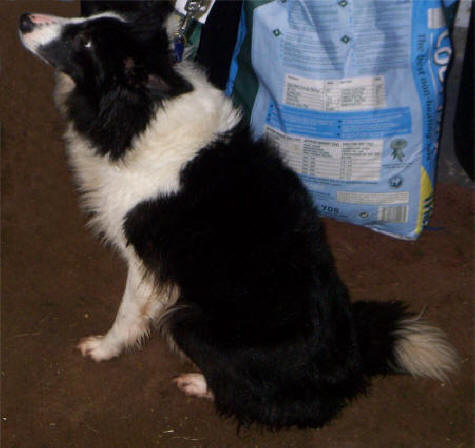

Tess had spent just over 4
months, from September 2009 to February 2010, as a stray.
Running
wild on Staney Hill overlooking Lerwick on the Shetland Islands.

The past winter had been particularly bad on Shetland, with heavy, prolonged, snowfall and temperatures down below -15c.
Tess had been kept on a farm to be trained as a sheepdog but did not show any interest in herding so in September 2009, she had been given away to a
local lad to be kept as a family pet. Within a week of him taking her home, she had run off and in spite of all his efforts, she would not come back to him.
He organised family and friends and went out searching for her to no avail, so he notified Shetland Islands Council Dog Wardens.

Tess had gone missing on Staney Hill, high moorland ground overlooking the town of Lerwick on the main Island of the Shetlands.
The uplands here are sparsely populated and there is plenty of room to get lost or stay out of sight
In spite of efforts of dog wardens and many local people, Tess had vanished and remained out of human contact for long periods of time. On the odd occasions she was sighted, she stayed well out of reach, running away if people approached her.
It is difficult to say why she was so reluctant to seek out human company and contact as she must have been hungry and cold.
There does not seem to be any indications of abuse, neglect or bad treatment in her past.
It is possible that the reason she originally ran off was a desire to find her way back to her original home, and having got lost and confused became reluctant to allow herself to be taken in by a stranger.
Many dogs brought up on farms have little contact with humans other than those they live with so have a natural distrust of people they are not familiar with.
We can all get homesick when away from familiar surroundings. So can
dogs.
During this period she must have caught rabbits and other small animals for food, scavenged outbuildings, eating whatever scraps she could find. She must have found some sort of shelter because she survived the extremes of the weather and was not seen or heard for long periods of time between occasional sightings.

On the odd occasions when there was a sighting, Ian Taylor and Ian Isbister, both Assistant Environmental Health Officers for Shetland Council would drive up into the hills in their pick up, sometimes alone, sometimes together and sometimes with others, to try and coax her in.
Over the long months of winter a number of organised and spontaneous searches were carried out by groups of local people concerned about the ability of a small dog to survive outside in the harsh winter environment of the Shetlands.
Tess managed to avoid all attempts to catch her (and most attempts to even spot her) until January 2010 when particularly severe weather, probably combined with the lack of any rabbits above ground to catch to eat, forced her down from the high hillside closer to human habitation in her search for food and shelter.
We are told that a local resident had left an over ready chicken on a door step for a short time (although we are not clear why!) and when they went to collect it, the chicken had gone. Later Tess was spotted in the distance and after that she was seen on several occasions hanging around.
She was also heard at night, howling but would still not let anyone approach her.
She showed the will and ability to survive, gaining the respect of people who also had to cope with the harsh Shetland conditions, but the weather was not improving and if she was to be sure of surviving winter something would need to be done quickly.
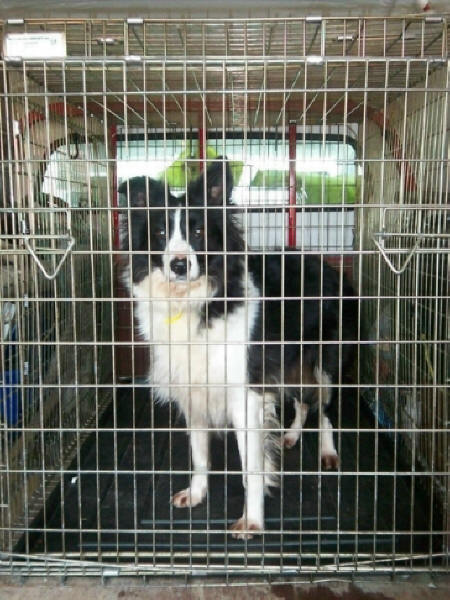
Ian Taylor and Ian Isbister decided the only course of action left was to try and trap her.
The Council agreed to the plan and they sent for a professional humane dog trap, which was loaned by Animal Health in Inverurie and the SSPCA helped ship it over from the mainland.
Once in possession of the trap they placed it in the area she had been seen hanging about and baited it with some gammon.
It worked, she was hungry enough to go for the food and the trap sprung.
An interesting observation extending from this episode is her present reaction to dog crates. One would half expect her to be wary of them, having been trapped by one and loaded into a van - a situation she had spent 4 months avoiding.
She also travelled down to us in a specially built flight case. But she is quite relaxed about dog crates.
Happy to sleep in one at night, goes freely in and out of it during the day and will store her biscuits under her bedding in her crate, popping in to retrieve them when she feels like eating them.
She is not stupid, on the contrary, but the experience of the trap has not left her with any lasting concerns.
It was now February 2nd, and having caught her at last, the first port of call was Lerwick Veterinary Practice for a check up.
They were surprised at how well she had survived her time alone on the hills.
She was a bit underweight (14.5 kg) , but fit and muscular. Temp 101.5.
It was noted she was in season (which may have been another reason she came down from the hills).
It was also noted that she had a healed scar and loose flap of skin on her right cheek and lip,
maybe the result of some prey putting up a fight.
They wormed her, treated her with Frontline and vitamins and fitted a collar. She went to the local pound and the dog wardens contacted the lad who had taken her from the farm to be his pet. Understandably he was reluctant to risk going through the same experience again and decided to sign her over to the Council so they could re-home her.
The Council pound where she was held was not a massive kennels, however she was not settling particularly well, would not eat from a bowl and was not eating the dog food provided and showing every indication of wanting to be off again.
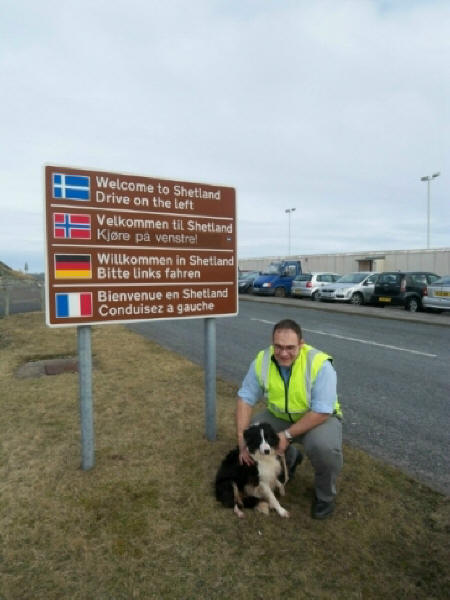
They were faced with a dilemma.
Tess had a nice nature but many social problems and needed rehabilitation and training before she could be re-homed.
The Council was not empowered to provide such services and funding to keep her in kennels was not a bottomless resource. The only option was to find a dog rescue charity that would take her in and perform the necessary duties of care.
The other alternative would be euthanasia, a course of action neither the wardens nor the Council were happy to consider. The irony of saving her from a death on the hills only to be put down because she could not be found a home was not lost on them.
They had all gained great respect and admiration for this little dog's spirit, her will to live and ability to survive against the odds.
Ian Taylor contacted the rescue on the mainland that normally took the dogs they could not re-home on the Island, but was told that in view of her problems they could not help Tess.
He then tried other rescues further away with similar results, until one of them told him to contact Border Collie Rescue.
We get dozens of calls a week from people needing to find new homes for their Border Collies and we always have a lot of dogs waiting to come in, however we try and give priority to dogs like Tess.
Over the years we have come to specialise in re-habilitating dogs with social problems and are fully aware that many rescue centres are not set up to provide such facilities and would consequently have to turn such dogs away.
It did not take us long to reach a decision and we agreed to take Tess in
Distance could have proved to be a problem, particularly as some of the travel required passing over a stretch of water!
Various options were discussed.
Initially, as soon as it was agreed we would take her, the priority was to make sure she was going to be safe from infectious diseases if moved to a new area, so it was back to the vet on the 4th March for the first stage of vaccinations and another check up to make sure she was fit to travel.
It was agreed that she would then remain in the pound for at least 7 days for the vaccinations to take some effect.
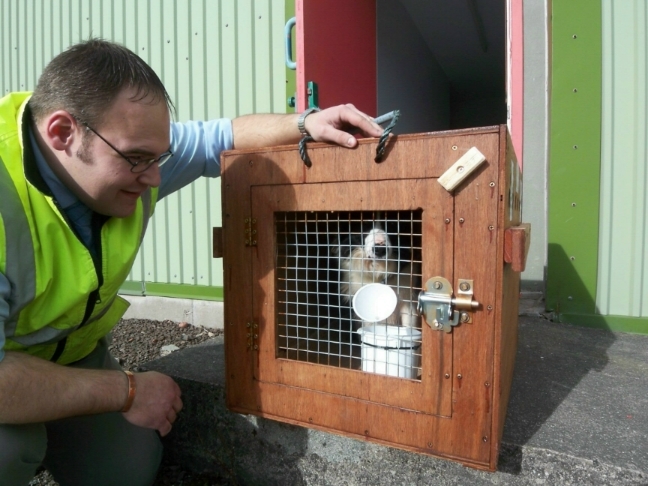
There was some concern as she had lost weight and condition in the kennels and it was obvious that the experience was stressing her.
With this in mind, Ian Taylor approached the Council, backed by Jim and Fiona from Lerwick Veterinary Practice, to ask for consent to have her flown from Sumburge airport on the Shetlands to Edinburgh airport where we would arrange to collect her.
This would greatly reduce the travel time involved and would be much smoother than using the ferry service, therefore reducing any stress she could experience on the journey.
To ensure safe travel a regulation standard air freight dog crate would be needed, but they are expensive, and the cost of having it returned to them empty also expensive.
The most economical solution was to have one made from wood to the regulation standard so the council arranged for a local craftsman to build one especially for her which she could stay in until we got her to the centre in York.
During the time we were making these arrangements, we had sent them a microchip pre-registered to Border Collie Rescue and they arranged for the vet to implant it.

The date was set for 15th March and her ETA at Edinburgh would be 5.20 pm, allowing time for unloading and clearance to be ready for collection at 5.45 (ish)
Over the preceding days there had been many calls and emails between us and Ian Taylor on the Shetlands while we worked out options and finalised details.
We were gaining a great deal of respect for Ian as, in spite of a heavy workload, he was dedicating a lot of time and effort to get it right for this little dog.
He had given us his home number and we knew much of what he was doing was outside working hours. His wife was also very understanding when we interrupted meals!
On the morning of the 15th we received an email from Logan Air confirming the flight arrangements and a little later a telephone call from Neil at North East Air Cargo, who were handling her transport, confirming arrival and collection times and what paperwork was involved.
We sent the van off at 12 noon, to allow plenty of time, with two people, Nicki Oliver as 'handler' and Mike Cooke as 'driver'.
It is never wise to transport dogs with just a single person in case of any emergency or accident.
Tess was put aboard the plane at around 3.15 and Nicki received a phone call from Ian Taylor on the BCR mobile to confirm she was in the air and on her way. By that time we were well on our way too!

It must be said that Tess could not leave the Shetlands without causing a final bit of excitement.
By one of those unusual coincidences that arise in rescue work, the man handling her departure and paperwork from Sumburge airport happened to be someone who had adopted a dog from us a few years ago.
He was more than surprised to be confronted with a dog in a flight case with an address on it with which he was already familiar and contacted us later to express his delight in being part of the process that got her safely to us.
So many people have been touched by this little dog and so many have played their part in her rescue.
Tess touched down without a hitch and was collected at the arranged time. By 6 pm she was on the road down to Yorkshire.
We have no photos of this stage of her progress, but Mike did get some video of her on the van at the airport and on arrival at the centre which can be viewed lower down on this page. Keep reading - you'll get there!
The initial impression Nicki Oliver got of her was that she was a friendly and
gentle little dog who was obviously frightened and intimidated by her experience but was coping very well.
Nicki has a quiet way with dogs and was able to coax Tess to the front of the travel crate and get a good look at her, even managing a tentative contact at the airport.
She travelled back to Yorkshire without a murmur with Nicki speaking to her from time to time in a reassuring manner.
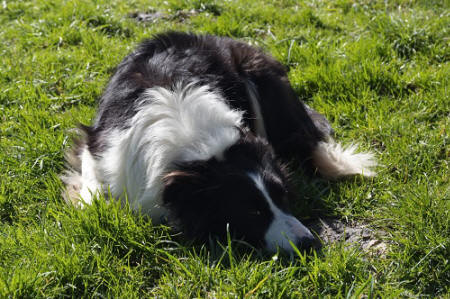
Having got her back to the centre - by that time it was 10.15 pm - NIcki climbed into the back of the van, shut the doors and got her out of the crate and onto a lead and then out of the van.
An initial stop in the orchard to relieve herself and then into a small room in the house where her quarters were prepared for her.
An examination of the travel crate showed it to be dry and clean. She had not messed or chewed or clawed to escape. She seemed to have done very well.
Once in the centre it was obvious that she was very frightened and intimidated, seeming to freeze up initially, however after a few minutes with Nicki she had relaxed enough to wag her tail and take an interest in her surroundings.
She was given a small meal and allowed to settle behind a mesh panel that allowed her to see what was happening in the room beyond while people kept her company until midnight before retiring to bed.
She spent the night quietly and the next morning NIcki took her out to our secure paddock area where she could be allowed off lead without fear of escape. As the photo opposite shows, she was very intimidated and spent a lot of the time skulking or laying flat on the ground trying to be very small.
It was decided that we would take the next couple of weeks very carefully and allow her time to get used to us and her surroundings before she was subjected to any assessments, external socialisation or contact with other dogs or new people - or even more photos. But she was to show us she was made of sterner stuff than we initially gave her credit for and she has made brilliant progress - as the video below will illustrate.
Shetland Tess 1, The Phantom Menace. From collection at Edinburgh and the fiirst 14 days at the centre.
Our thanks go to all of the many who became involved in her rescue, but particularly to Jim and Fiona at Lerwick Veterinary Practice for all their work on her behalf and for seeing her potential, to Animal Health in Inverurie for the loan of the dog trap and to the SSPCA for helping to ship it over to the Islands.
Last but not least, to Ian Taylor and Ian Isbister, Assistant Environmental Health Officers for Shetland who, along with Shetland Islands Council, showed consideration and humanity, going the 'extra mile' to make sure this spirited little dog has a chance of a secure future.
It is wonderful to see all these agencies working together to successfully bring this situation to a satisfactory conclusion.
After all Tess has been through and her obvious fight to survive, she has earned and deserves all the help we can give
And after the end of that video, this is how it progressed - 29th March on -

April 2010
Since the above video was made Tess has made great progress and had now been with us for a month.
Over the
latter two week period we had gradually increased her intake and variety of food and
by this time she would eat anything we put in front of her from her bowl (and is not beyond a little thievery to supplement her diet - old habits will die hard).
She got two meals a day + little snacks in between and biscuits at night. Her snacks
were
whole-meal bread with low fat spread (for additional vitamins and oils).
She was exercised gently and regularly to keep her muscle tone up.
All in she had gained 2.5 kilos since she came into our care a month
before.
Her confidence has grew and although she would still start at a sudden movement or noise close to her, it was not blind panic, more of a reflex survival reaction.
Noise, on the whole, did not seem to worry her much. She took absolutely no notice of bangs in the distance, gunfire or bird scarers and household noises that originally scared her now had little or no effect on her at all, other than to arouse and stimulate her curiosity.

Once she had settled in and was confident with Nicki and Mike at the centre, we started to gradually expose her to more people.
Her accommodation in the house was a small room that looked out onto the 'dogs room' which is a large through room where people and dogs come and go all day.
The door to this retreat had a metal mesh panel that fits it and allowed dogs inside to see what is going on.
At the back of the room
was a deep shelf, under which was a covered crate where she (or other dogs) could go if they felt the need and
gain a sense of security from being enclosed in a den like environment.
This facility allowed shy dogs to see what is going on but feel protected from it.
If they felt insecure they could go to the crate and watch from the back of the room. If bold they could watch from the doorway. The mesh panel worked two ways, it kept the dog in and, as far as the dog was concerned, it kept threats out.
Tess had responded well to meeting her first 'new people' because she had been able to observe then first from this secure area. When they come face to face, they are not unfamiliar. This had helped her accept them more rapidly. From this she had graduated to meeting total strangers without fear. In the pictures above / left she is meeting a young lad she had never met before and quite enjoying it.

For the first couple of weeks we would not allow her free run off the lead outside of a secure area.
This is advice we give to anyone taking on a rescue dog so we would be daft not to follow it ourselves.
She had been allowed to run free in the secure paddocks and grazing areas, and had displayed no inclination to leave Nicki's side so we had been able to allow her a great deal more freedom in the subsequent two weeks.
She frequently accompanied Nicki on her rounds as she worked in different areas of the centre and had complete free run of the place, although we would not (yet) leave her outside unaccompanied.
This additional freedom had allowed her to broaden her experience with other dogs by meeting every one of them currently at the centre.
It had also allowed her some additional experience of meeting people in different situations by coming into contact with other volunteers as they
went about their work with the other dogs.
As she had got to know the routines she would sometimes run ahead and wait for Nicki to catch up but when she reached a place where there is a choice of direction to go in she would wait until she saw which way Nicki was going to pick and then carry on.
She had become quite adept at predicting where Nicki was going next. This behaviour is interesting in that she only displays it within our centre's boundaries. The photo above shows her leading Nicki over to the quarantine area to feed the dogs there.
Her behaviour off the lead outside the centre
was different.
We were lucky in that there are a lot of farm tracks around the centre where dogs could be taken on longer walks and Tess had done many miles on the lead, and
later off the lead.
Outside of our own area she would walk close to, and slightly behind, her handler as can be seen in the photo below left. She had adapted her behaviour in these different situations herself as she was aware that Nicki is more concerned about where she was outside the centre than inside.
It really was an indication of her willingness to adapt and please her handler - a typical Border Collie trait. At heart she is a very obedient little dog who just wants to get it right.
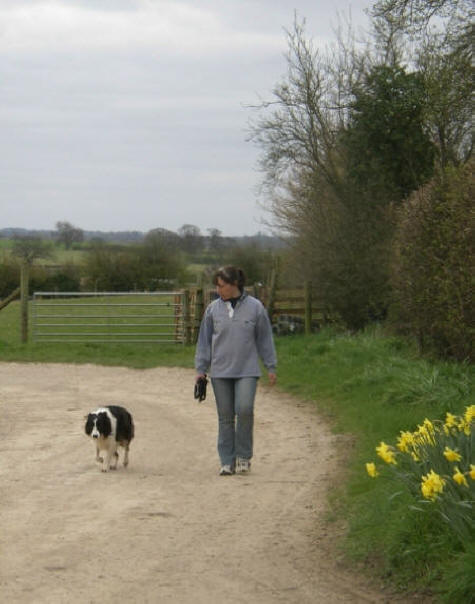
She had two sheepdog assessments to date. She
was obviously very familiar with sheep and would walk through a field of them without a glance left or right.
If asked or prompted she showed that she has had some basic sheepdog training as she would do a light little outrun and adopt the 'pose' of the working dog and 'eye' the sheep.
It was clear this was more a wish to please than a drive or desire to herd or work livestock. Really she would rather not bother - she would prefer not to and she had no real drive or incentive to herd.
It is easy to see why she was deemed a non worker and offered as a pet.
Great, if that was her choice we were happy to go along with it!
We approached other formal assessments carefully, trying to gauge the speed of her passage through rescue to fit the time it took her to develop her confidence.
This is not something that should be done quickly on any dog - unless you are going to base your conclusion on incorrect assumptions. An inhibited dog will not behave normally and it is normal behaviour we need to see.
There had been a fair bit of grooming going on, an experience she seemed to enjoy and which had helped her bonding. Also, inside the house we had been acclimatising her to various household appliances, most of which scared her when she first came across them.
TV was fascinating to her. She had now seen both sides of the camera as a TV crew from the Yorkshire Television 'Calendar' program contacted us about doing an article on her story.
We briefed the reporter, Mike Hill, before he arrived with a cameraman to film her. We were unsure as to how she would react to the equipment and to two total strangers.

It turned out that Mike was quite a tall man - and the cameramen was not small either! Big tripod with big black camera and a microphone in a big furry wind shield. They were both very sensitive to her and the initial introduction was conducted outside and very carefully. Within minutes she had accepted them and was running around the orchard more or less ignoring them.
They got the footage they required and took away some of the footage we had filmed previously. The following day her story was broadcast on Yorkshire, Tyne Tees and Scottish TV.
She was loose in the house when one of the broadcasts went out and came rushing into the dining room from the sitting room where the TV was on. She was obviously excited and we followed her back into the sitting room and saw her on TV.
At first we thought that she had recognised herself, but quickly realised she was reacting to the sound of Nicki's voice coming out of this box and the sight of Nicki on camera being interviewed. She looked from the screen to Nicki with obvious puzzlement.
You had to be there to appreciate it!
Curiosity was one of her great driving forces and it had helped a lot in speeding her rehabilitation. Although she was wary of the 'unknown', often her curiosity got the better of her and she had to work up the courage to investigate.
In the picture above right, there is a young Spaniel in the crate in the back of the car. She knew something was going on but could not see from the ground. Eventually she worked up the courage to have closer look and satisfy herself as to what it was. Just a Spaniel.
Once she knew she ignored it.
She was quite a serious dog and did not seem to have learned to play. When other playful young dogs tried to engage her she simply backed off and eyed them with mild amusement. She
showed a sense of humour and reacted positively to laughter and chuckling.
She was slowly warming to invitations to play.
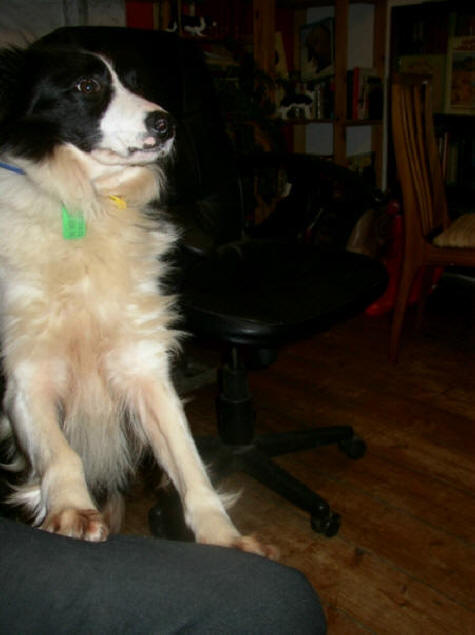
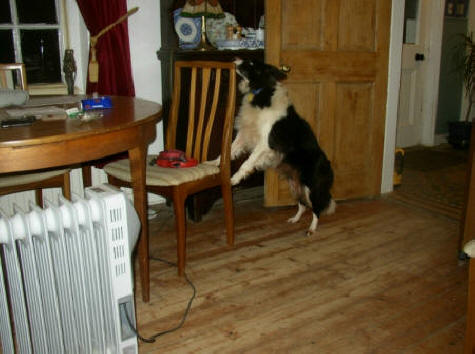
She had also found her voice at last and would greet us in the mornings with a throaty 'urrffing' sound which she uses when she is excited or if she wants to attract attention.
Other examples of her 'need to know' have been caught on camera.
The picture on the left shows her balancing on Mike's knee in the office to see what he was doing on the computer.
The one above shows her exploring and investigating the dining room in great detail and on all levels.
In the house she had been clean and careful, although she would steal food if she could.
Having said that, if we
ate in front of her she did not demand food from us and would not try and steal food from other dogs bowls - however if our old Dot tried to steal food from her bowl, she defered to her and allowed it.
This was a great improvement on the little dog that guarded every morsel with its life when she first came in.
Another aspect of her broadening experience
was life outside the centre.
We
were remote and quiet and in order to show her more of life she needed to get out and about a bit. She had travels a long distance, but in crates, so we
took her out in the van a few times and into Stamford Bridge on a couple of occasions where she had been able to meet people outside the shops, see them walking on the pavements and see the traffic on the main A166 road as it passed through.
It's very clear that she had some previous experience of being inside a vehicle before she came to us and she really enjoyed travelling around, looking out at the world passing by.
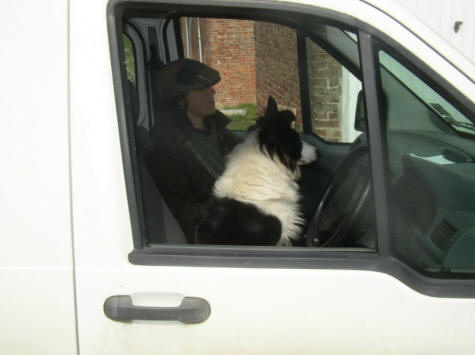

Nicki gave Tess a couple more short sessions of the Trust Technique to keep her relaxed, receptive and boost her confidence and self reliance.
Tess responded very well and her progress
was so good we were soon considering potential homes for her from applications on our lists.
We felt pretty confident that if her progress continued at this pace she would be ready in less than a month.
We knew that whoever we passed her on to would have to be capable and prepared to carry on as we have, gently and carefully guiding her to self confidence and independence yet creating a wish within her to bond and value their friendship and company.
They would be rewarded..
So after a long day exercising, learning new things, having new experiences, eating, meeting new people and ignoring the sheep, Tess seemed to like nothing more than to get her head down, have a snooze and relax in the company of friends, secure and confident no harm would come her way and the next day - she could do it all again


Tess is a remarkable dog.
The inner strength that enabled her to adapt and survive in the harsh conditions of a high moor on Shetland and in the harsh environment of a Shetland winter have also stood her in good stead in adapting and embracing a completely different lifestyle with us on the mainland in a domestic environment she had previously shunned.
She was not a well socialised dog when she came to us and it is common in dogs of her breeding and background to be frightened of anything new that they do not understand, but Tess does not display the fear you would expect in most of these situations. She withdraws when she is outfaced. There is a certain wariness and caution when approaching new experiences but it does not prevent her from coping with a situation and learning from it, and having understood it, embracing it.
Her drive to survive may have been tested to the extreme and she may well have proved to herself that she is capable and need not be afraid of anything, just careful.
Perhaps this illustrates one aspect of the human/canine relationship which is basically bad for the dog. We tend to be over protective.
Dogs that are allowed to face obstacles with or without our support will overcome them and grow. If we support them they grow with less trauma being involved but if we over protect our canine friends we deprive them of that opportunity to learn and grow stronger and we keep them dependent on us for protection. Perhaps many of us are inclined to enjoy that dependence.
Tess shares her life with people and joins in because she wants to. She is willing to please because she wants to please - that is typical Border Collie - but she is far from dependent and has an inner strength we should all admire and encourage in our own dogs.
Shetland Tess 2 - The Awakening - covers April 2010 onwards, with an interview with her new owner after she was re-homed.
Tess and her people went back to Shetland in 2016 and she re-visited some of her old haunts
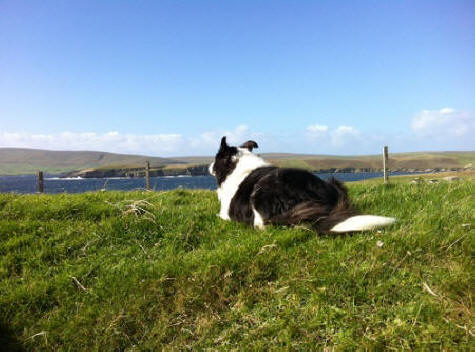
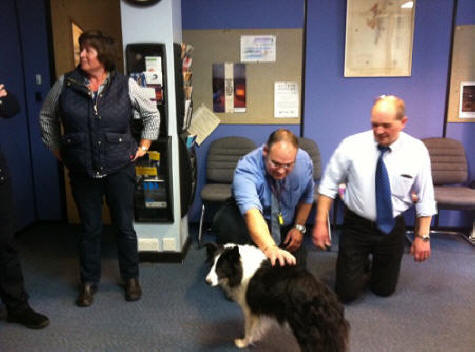
Tess looking pensively out to sea in the
picture on the left. It was the first time she had been back to
Shetland since she was flown off to meet us at Edinburgh and it's
interesting to speculate what she was thinking about.
In the picture on the right she is meeting the two dog wardens, Ian
Tailor and Ian Isbister, who had spent so much of their time over that
harsh winter trying to coax her down from the hills. It was a little
bit
emotional.
Again, interesting to speculate what she was thinking about. She
wasn't saying - but obviously bore no grudge.
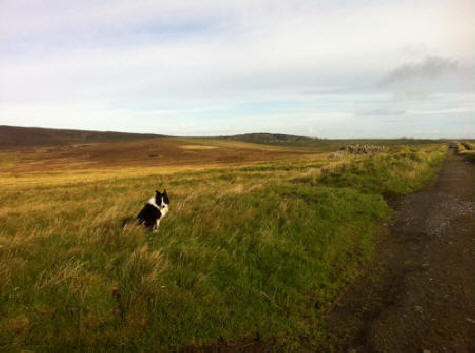
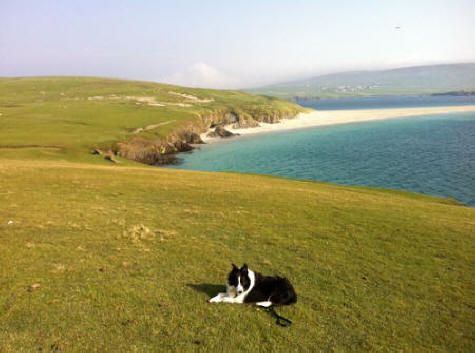
On the left, Tess is up on Staney Hill which
rises above Lerwick, the capital of Shetland. It's a wild and bleak
place. Wet and boggy at the best of times and harsh in wintertime
with little shelter to be had. This is the environment in which she
lived for nearly five months over a particularly nasty winter.
On the right she's up on the cliffs enjoying a bit of Shetland
sunshine and looking thoughtful. We understand she seemed to find
familiarity with the people she met and places she went to but did
not exhibit any concern.
In February 2017 we received this update on our Celebrate Your Dog Facebook page
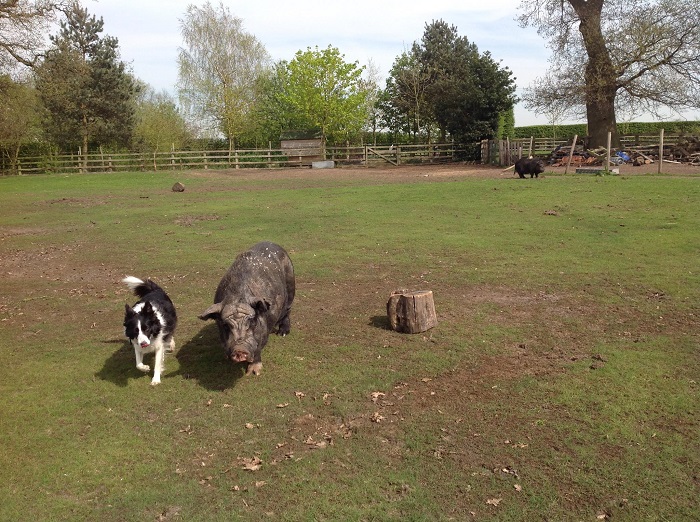
Shetland Tess came to me from BCR after being taken off the Shetland Isles having been roaming feral for four months.
She was very unsocialised and had to learn to trust humans but if you do earn her trust she is the most loyal companion. She is now eleven or thereabouts. Such a peaceful, gentle little soul.
She still retains her independent character from when feral which is one of the things I love about her.
She has a number of friends apart from other dogs, including cats, horses and pigs.
Tess likes nothing better than a very long walk or in her case run. She loves running...
Something else for the record -
We received this email from Hazel Holland, resident of Shetland, on 23rd April 2010
I am just another Joe Bloggs who lives in Shetland.
I was driving from the country into Lerwick to do my shopping one January morning and passed a poor, sad, scruffy dog peering at me through a fence. Such sad eyes, I just could not forget that wee face.
On the homeward journey I parked my car, got the piece of meat I had bought, climbed over the fence and started to look for my sad friend. No luck.
The following day it was snowing so I just had to go back and have another look, dragging my husband, the meat, a blanket and a box. We hunted all over and still no sign of my friend. Unwillingly we went home.
I have never forgotten his soaking wet wee face. Would you believe it, weeks after, I opened the Shetland Times and there was my dog, with a name, Tess and her full story.
What a relief! Now I have discovered your web-site and there, again, is Tess.
How fantastic everyone has been, so generous with their time and money.
Thank goodness there is still good in this world, I lose heart sometimes.
You have given so much patience and time with Tess she looks a different and very happy dog, and at last I can sleep at night in peace knowing she was saved and living the life of Riley
Sincere thanks to everyone involved. Hazel
If you are interested in adopting a
Border Collie from us,
please do not write to us or email us - we
want to speak to you before we start the process.
Please phone us
during office hours. Details here.
Calls to our office and mobile
will only be answered during our office hours











































































